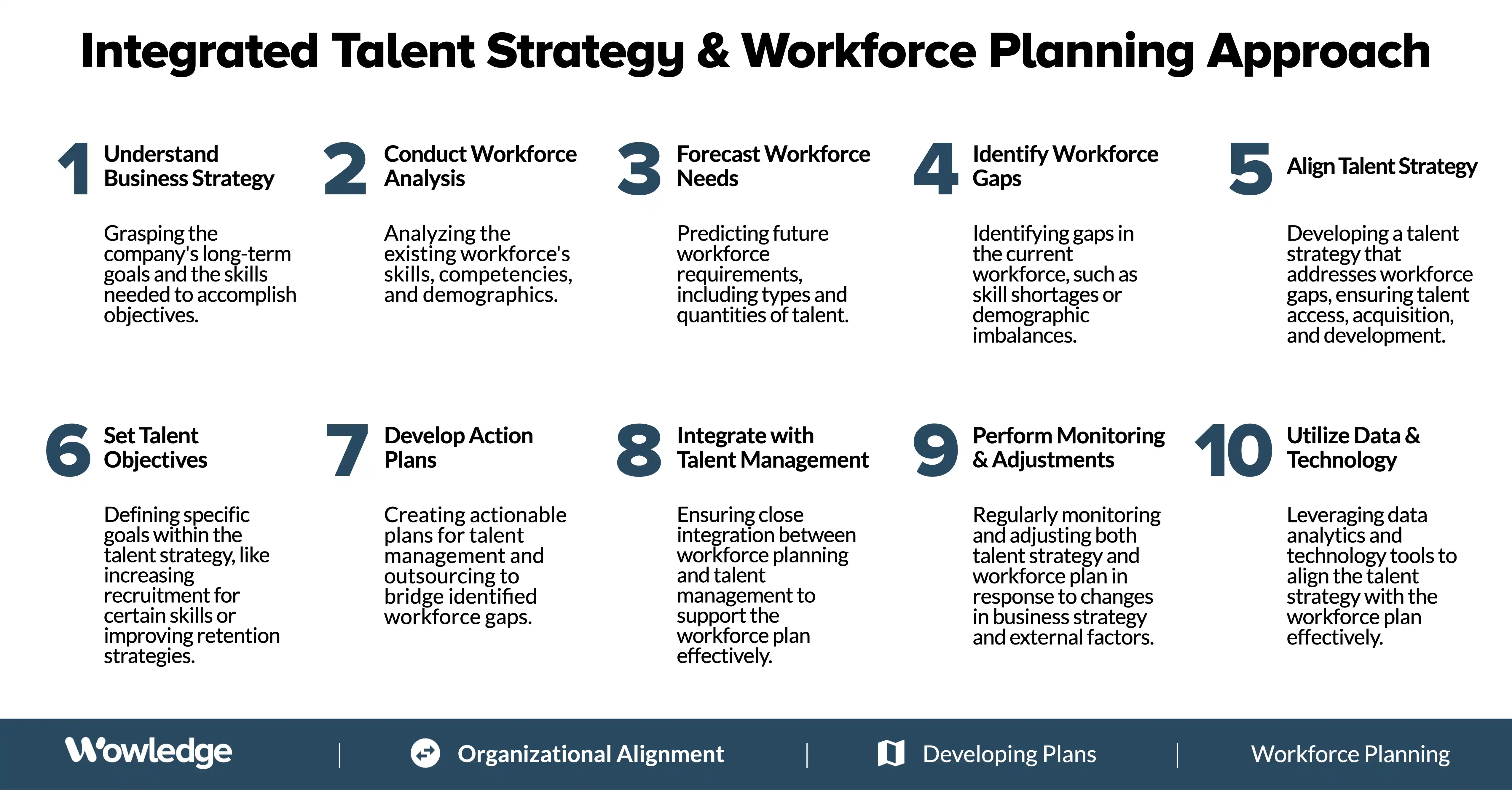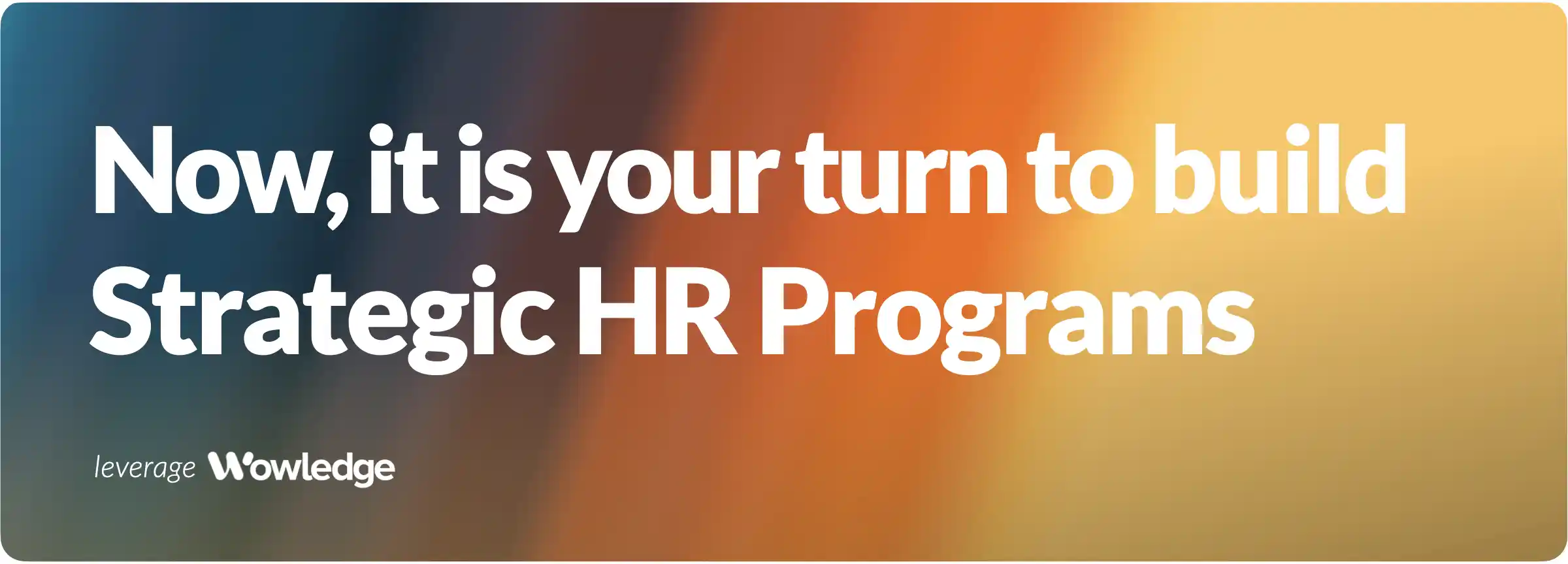Talent Strategy is a broad approach to defining the organizational skills and capabilities that are required to meet business objectives. It clarifies the types of skill sets that will be required and how those skills will be acquired, developed, or accessed within the organization or in the market. It helps ensure that the company has the right mix of people to be successful and grow in the future.
Similarly, Strategic Workforce Planning, often abbreviated as SWP, is a systematic and forward-looking process that organizations use to align their workforce with their long-term business objectives and goals. It involves identifying the workforce capabilities, skills, and talent required to support the organization's strategic plans and ensuring that those resources are available when needed. Strategic workforce planning aims to bridge the gap between an organization's strategic vision and its workforce capabilities, ensuring that the right talent is in place to execute the strategy effectively.
Talent strategy and strategic workforce planning are then two essential approaches that businesses use to make sure they have the right people in the right places for success. Talent strategy is the big picture plan, like the architect's design for a building, and SWP represents the detailed blueprint that guides the construction. Talent strategy is about defining future talent needs and setting the most advantageous mechanisms for accessing the proper set of capabilities to help the company meet its business requirements. Talent strategy and workforce planning work together harmoniously to reach a common goal. Talent strategy defines the requirements, and SWP identifies the details to make those goals happen.
Differentiating Talent Strategy from Workforce Planning
To leverage talent strategy and workforce planning most effectively, it is helpful to understand how they differ from each other and how the two are closely tied and complement each other. While talent strategy is broader and focuses on defining the skills and capabilities required for future success at a strategic level, workforce planning is a more detailed, operational process that aligns current workforce capabilities with future business needs.
To provide further clarity, it is necessary to review their distinct elements, interactions, and how each process feeds from each other.
Key elements of talent strategy include:
- Alignment with business strategy and objectives.
- Identification of required skills and capabilities.
- Strategies for talent acquisition, development, mobility, retention, or subcontracting.
- Consideration of internal and external sources of talent.
Key elements of workforce planning include:
- Workforce analysis and forecasting.
- Gap analysis.
- Scenario planning.
- Strategy implementation to address workforce needs.
There are also key interactions between the two processes. on one hand, talent strategy provides the vision and defines the skills and capabilities needed, which serves as an input for workforce planning. Conversely, workforce planning identifies how to operationalize the vision by ensuring that the organization has the appropriate talent in place, which may inform adjustments to the talent strategy. The output of the workforce planning exercise, which includes detailed plans for recruitment, development, and workforce management, feeds back into the talent strategy to ensure that it remains aligned with the company's operational realities and needs.
Fundamentally, talent strategy sets the direction for the kind of workforce an organization aims to build, and workforce planning translates this into actionable plans and processes to build and manage this workforce effectively.
How a Talent Strategy is developed in conjunction with Workforce Planning
Developing a talent strategy and strategic workforce planning are closely intertwined processes, as a talent strategy plays a vital role in supporting an organization's workforce planning efforts. By developing a talent strategy integrated with SWF, organizations can ensure that their talent-related efforts are tightly aligned with the broader business objectives, enabling them to build a workforce capable of supporting and driving the organization's success. Here's how a talent strategy is developed in conjunction with strategic workforce planning:

- Understand the Business Strategy: The process begins by deeply understanding the organization's overarching business strategy and objectives. This includes identifying the company's long-term goals and initiatives and, in the context of developing a talent strategy, the skills and capabilities required to achieve them.
- Conduct Workforce Analysis: In parallel with understanding the business strategy, organizations analyze their current workforce. This workforce planning-based analysis includes assessing existing employees' skills, competencies, and demographics.
- Forecast Workforce Needs: Strategic workforce planning involves predicting future workforce requirements based on the business strategy. Typically leveraging quantitative methods, it identifies the types and quantities of talent needed and where and when they will be needed.
- Identify Workforce Gaps: A critical component of workforce planning is the identification of gaps between the projected workforce needs and the current workforce. These gaps may include shortages of specific skills, succession planning needs, or demographic imbalances.
- Align Talent Strategy: The talent strategy is then developed to address the workforce gaps and align with the business strategy. It outlines how the organization will attract, access, develop, and retain talent using various methods and internal/external sources.
- Set Talent Objectives: The talent strategy sets specific objectives and goals, such as increasing recruitment efforts for particular skill sets, launching leadership development programs, or improving retention strategies. It clarifies how many skillset types can be accessed via internal methods (e.g., development, mobility, retention, automation) or external methods (e.g., hiring subcontractors, consultants, temporaries).
- Develop Action Plans: The talent strategy leads to creating actionable talent management and outsourcing plans and initiatives to bridge the identified gaps. These may involve recruitment strategies, training and development programs, performance management improvements, diversity and inclusion initiatives, and subcontracting tactics.
- Integrate Workforce Planning and Talent Management: The talent strategy and workforce planning efforts should be closely integrated to ensure that the organization's talent management-related initiatives directly support the workforce plan. For example, if there's a projected shortage of a particular skill, the strategy can include specific hiring, training, or outsourcing plans to address this gap.
- Perform Monitoring and Adjustments: Both the talent strategy and the workforce plan are iterative processes. Organizations must continuously monitor their progress, assess their initiatives' effectiveness, and make necessary adjustments. As the business strategy evolves and external factors change, so should the talent strategy and workforce plan.
- Utilize Data and Technology: Data analytics and technology tools play a significant role in both processes. Workforce analytics and management software can help analyze and visualize workforce data, making aligning the talent strategy with the strategic workforce plan easier.
The defining capabilities leveraged in combining Talent Strategy with Workforce Planning
Melding talent strategy with strategic workforce planning requires utilizing specific capabilities to ensure that an organization can effectively align its talent efforts with its long-term business objectives. The defining capabilities leveraged in this process include:
- Strategic Vision and Alignment: Understanding the organization's long-term business strategy and aligning talent strategies with it. This capability involves seeing the bigger picture and comprehending how talent strategically accomplishes business goals.
- Data Analytics and HR Technology: Utilizing data analytics, statistical techniques, and HR/business technology. This capability allows for collecting, analyzing, and interpreting workforce data to inform talent strategies and workforce plans. It helps in making data-driven decisions and predictions.
- Workforce Analysis and Planning: The capability to conduct comprehensive workforce analysis, including demographic, skills, and competency assessments, and to project future workforce needs with predictive methodologies. Skilled professionals can identify gaps and challenges in the workforce.
- Talent Management Expertise: Talent management expertise includes knowledge of best practices in recruitment, training and development, performance management, succession planning, and retention strategies. Professionals who understand how these can be optimally used and integrated can design and execute effective talent management initiatives.
- Change Management: The capability to manage and guide organizational change is crucial, as blending talent strategy with workforce planning often involves implementing changes in HR processes and practices. Professionals with this skill can help build programming to help impacted employees adapt to new strategies and processes.
- Communication and Collaboration: Effective communication and collaboration skills ensure that talent strategies are well-understood and integrated across the organization. This capability involves working closely with various departments and teams to align talent efforts with business goals.
- Adaptability and Flexibility: The capability to adapt to changing business conditions and revise talent strategies accordingly. An adaptable approach allows organizations to respond to evolving market dynamics and workforce needs.
- Leadership and Influence: Leaders who can influence and gain buy-in from executives, managers, and employees are essential to successful talent strategies and workforce plans. Strong leadership skills are crucial for driving change and aligning talent efforts with strategic objectives.
- Project Management: Effective project management capabilities for overseeing the execution of talent initiatives and workforce planning projects. This involves setting goals, defining tasks, allocating resources, and monitoring progress.
- Continuous Learning and Improvement: The capability to continually learn and improve talent management practices. Professionals and organizations should stay current with industry trends, adapt to new methodologies, and refine their talent strategies based on feedback and outcomes.
- Diversity and Inclusion Competence: As diversity and inclusion play a growing role in bringing innovation and creative solutions to the future work, having competence in these areas is essential. This capability involves promoting diversity, equity, and inclusion throughout the organization.
- Risk Management and Contingency Planning: Identifying potential risks and developing contingency plans. These skills are essential, especially given those inherent in mixing employee and contingent workforces at scale. Talent professionals should be prepared for unforeseen challenges impacting workforce planning and talent management.
Effectively integrating talent strategy with strategic workforce planning is a complex process that requires a multifaceted skill set and a holistic approach to human resource management. Organizations often rely on cross-functional teams with diverse capabilities to align their talent strategies with broader strategic objectives.

Enabling Practices & Resources
Core workforce planning is a business-aligned process that identifies and describes the current level of employee headcount, assesses future needs based on both internal strategies and external trends, and generates an employee replacement analysis.
A talent strategy defines the talent needs and associated objectives necessary to meet top business goals. It is both an integral part of the HR strategic plan and a direct informer of the talent management strategy and planning process.
A format for guiding and recording the planning of both employee volumes and strategic actions to be taken to close talent gaps projected to occur in the future population of critical role workers for workforce planning uses.
